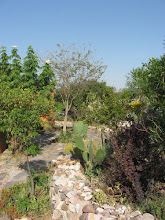Mini Milpa: Part One
While we are waiting to sell our houses and lots here (the purpose of this Website, of course), we are fully living our lives, as we imagined them. We are just putting the last touches inside of Casita Laberinto; touches of paint, getting the Inner Patio Fountain running, a detailed cleaning to rid the house of Construction dust and rubble. And, again at Casita Laberinto, we are working on the last major project, the Outdoor Patio. We are paving the ground with the red bricks known as tabiques and putting up a shaded area, made of Carrizo.
And we are Gardening at both places. At Casita Dos Arbolitos, our Shelter Gardens have been providing Greens, Lettuces, Basil and Herbs. Our covered Terraces have started to produce Cucumbers; and the tomatoes are green and growing. The Beans are just beginning, but look healthy and ready to climb the trellises. In the Orchard, lots of Citrus, especially Limes; and, on the ground below, the Butter Squash have already been producing and are maturing in the field. And our Zucchini has given us its first fruits, which we promptly turned into Zucchini Pancakes.
Most of the planting at Casita Laberinto has been for infrastructure. There are exceptions to the rule, however, most of them accidental. In many of the places that we used our neighbor, Don Camarino's compost (rich from mixed animal manures), there are squash and melons growing without plan. We'll find out what they are, once the fruit begins to develop. The other area that is growing something other than infrastructure is my Mini-Milpa. This is to say, a small patch, turned into a cornfield. For the whole story on growing and harvesting corn, see: https://sites.google.com/site/casitadosarbolitos/SMA/journal-blog/makingthepefecttortilla. For more on what to do with the corn afterward, see: https://sites.google.com/site/casitadosarbolitos/SMA/journal-blog/makingtheperfecttortillaparttwo.
My mini-milpa is one last opportunity to watch the age-old process, which has gone on, in some form, here in Mexcio, for millenniums. The corn I'm using is from our neighbor and part-time worker Genaro. It is a native variety, which is well adapted to this climate, environment, rainfall and altitude. Genaro uses the same corn every year, having saved seed from the previous harvest. The proof of its strength is in yearly yields, which are high, its natural ability to resist pests, and the fact that, because the typical Campesino dry farms, it requires little or no water other than the rainy season itself, which can and has gone several days without any rain at all.
Once I worked the soil and planted the seed, a week ago yesterday, there was, indeed little or no rain. On Monday, when Genaro came to work at the Casita, I expressed my concern regarding the rain. He grabbed a handful of soil and felt and then told me that---although it felt pretty dry to me---it was "humido," which is to say, moist. Since he's been doing this for decades, since working along side his father, as a small child, I deferred to him. Since then, there have been a couple of measurable rains and the corn has started to break ground. Below are the first pictures of the Milpa. More update and comments, as the process goes along.
Mini Milpa: Part Two
Well, it's been a few weeks since I planted my Mini Milpa. Each week, when Genaro, our neighbor and part time worker, comes for his 4 hours a week, we take a look at the Milpa and he dispenses a bit of country wisdom about how to care for it or what it means to be growing corn out here, in the the "campo." Now that the Corn and Beans are starting to grow (though we could use a little more rain, at this time in the cycle), Genaro told me that it is time to bank up the Corn/Bean Rows. This means weeding and then pushing the dirt up on to the rows so that it supports the growing Corn Stalks better and also keeps the moisture in the ground.Because we have had a couple of weeks of dry weather, a lull in the Rainy Season, some of the Corn Fields look a bit thirsty. Still, others look as if they are flourishing. Genaro says that this is because some of the campesinos have been experimenting with Chemical Weed Killers (a new phenomenon, here in the countryside). Genaro suggests that the weed killer has a two-fold effect. First, it is his observation that the chemicals work fine for killing unwanted greenery, but that they make the plants thirsty. This may be true. However, Genaro's other observation may be most accurate (or, certainly, it may be a combination of the two). Those people growing Corn that are practicing the old fashioned methods of weeding and banking the dirt, are protecting the soil from excess evaporation, as well as given extra support to the stalks.
This week, I'll be banking the rows of my Mini Milpa. In growing this Corn (and Beans), I am, according to Genaro, linking myself to the land and culture. Genaro tells me that there is a dicho, a saying that, in translation means, "that wherever you see some Corn growing in a person's yard, you know that there lives a Mexican.
For A Slide Show of the Milpa, at this Stage, Click Here!!

No comments:
Post a Comment